Rice Husk Research: From Environmental Pollutant to a Promising Source of Organo-Mineral Raw Materials
Abstract
:1. Introduction
2. Materials and Methods
2.1. Materials
2.2. Methods of Analysis
2.2.1. Infrared Spectroscopy
2.2.2. Scanning Electron Microscopy
2.2.3. Determining Rice Husk Composition
2.2.4. Thermal Analysis
2.2.5. Temperature-Programmed Desorption Mass Spectrometry
2.2.6. EPR Spectroscopy
2.2.7. Transmission Electron Microscopy (TEM)
- -
- On the EM-125K device (Sumy electronic devices plant, Sumy, Ukraine) by the method of direct observation of translucency by using the microdiffraction. The samples were prepared by the method of dry preparation, i.e., by the method of dry application of the agent to a collodion backing film and by the method of one-stage carbon replicas with extraction. During the microdiffraction studies, the photographing of diffraction patterns was performed.
- -
- On the Transmission Electron Microscope Philips EM 301 (Philips, Amsterdam, Netherlands) at an accelerating voltage of 80 kV in the range of electron microscopic magnifications of 13–80 thousand times. The images were recorded with an Olympus C-3040 digital camera, which was operated via computer using the Image Scope M software (Systems for microscopy and analysis (SMA), Moscow, Russia). The objects were prepared as follows. A small quantity of the sample was ground in an agate mortar. The resulting powder was applied to an object copper grid previously coated with an amorphous carbon backing film. The object grid with the applied sample was fixed into the microscope object holder and inserted into the microscope column [25].
2.2.8. Rice Husk Carbonization and Extraction of Silicon Dioxide
3. Results
3.1. Infrared Spectroscopy Study of Rice Husk
3.2. SEM Study of Rice Husk
3.3. Rice Husk Composition
3.4. Investigation of Rice Husk Thermal Degradation Process by Thermal Analysis
3.5. Study of Rice Husk Pyrolysis by TPD-MS
3.6. Investigation of Rice Husk Structural Changes during Carbonization by EPR Spectroscopy
3.7. Characteristics of Carbonized Rice Husk Supramolecular Structure
4. Discussion
- -
- Release of volatile organic substances, aldehydes, and terpenes, a small amount of which causes adverse effects on health.
- -
- Unsatisfactory physical and mechanical properties of the resulting materials, providing mainly as use for decoration and furniture production, but limiting their use in the construction industry.
- -
- Use of a large number of highly toxic and inflammable artificial organic polymers (formaldehyde, epoxy, and other resins such as binders, various types of hardeners, plasticizers, and adhesives) since almost all technologies are based on pressing plant biomass. Strengthening the mechanical properties usually requires increasing the amount of resin binder. Increasing fire resistance and improving other properties such as sound absorption, impact resistance, and thermal conductivity is associated with a more complex composition of the blend, i.e., increasing the number of ingredients and different methods of processing can increase in the cost of the finished material.
5. Conclusions
Author Contributions
Funding
Institutional Review Board Statement
Informed Consent Statement
Data Availability Statement
Acknowledgments
Conflicts of Interest
References
- Kazakhstan in a New Reality: Time for action. President of Kazakhstan Kassym-Jomart Tokayev’s State of the Nation Address. Available online: https://www.akorda.kz/en/addresses/addresses_of_president/president-of-kazakhstan-kassym-jomart-tokayevs-state-of-the-nation-address-september-1-2020 (accessed on 1 September 2020).
- Kolesnikov, A.S.; Kenzhibaeva, G.S.; Botabaev, N.E.; Kutzhanova, A.N.; Iztleuov, G.M.; Suigenbaeva, A.Z.; Ashirbekov, K.A.; Kolesnikova, O.G. Thermodynamic modeling of chemical and phase transformations in a waelz process-slag—Carbon system. Refract. Ind. Ceram. 2020, 61, 289–292. [Google Scholar] [CrossRef]
- The Strategic Plan for Development of the Republic of Kazakhstan until the Year 2025, Has Been Approved by the Decree of the President of the Republic of Kazakhstan No. 636. Available online: https://adilet.zan.kz/rus/docs/U1800000636 (accessed on 15 February 2018).
- Ghosh, R.; Bhattacherjee, S. A Review Study on Precipitated Silica and Activated Carbon from Rice Husk. J. Chem. Eng. Process. Technol. 2013, 4, 1000156. [Google Scholar] [CrossRef] [Green Version]
- Efremova, S.V. Rice hull as a renewable raw material and its processing routes. Russ. J. Gen. Chem. 2012, 82, 999–1005. [Google Scholar] [CrossRef]
- Zharmenov, A.; Yefremova, S.; Sukharnikov, Y.; Bunchuk, L.; Kablanbekov, A.; Anarbekov, K.; Murtazayeva, D.; Yessengarayev, Y. Carbonaceous materials from rice husk: Production and application in industry and agriculture. Inz. Min. J. Pol. Min. Eng. Soc. 2018, 1, 263–274. [Google Scholar] [CrossRef]
- Foo, K.; Hameed, B. Utilization of rice husk as a feedstock for preparation of activated carbon by microwave induced KOH and K2CO3 activation. Bioresour. Technol. 2011, 20, 9814–9817. [Google Scholar] [CrossRef] [PubMed]
- Ahiduzzaman, M.; Sadrul Islam, A. Preparation of porous bio-char and activated carbon from rice husk by leaching ash and chemical activation. SpringerPlus 2016, 1, 1248. [Google Scholar] [CrossRef] [Green Version]
- Liu, Y.; Guo, Y.; Zhu, Y.; An, D.; Gao, W.; Wang, Z.; Ma, Y.; Wang, Z. A sustainable route for the preparation of activated carbon and silica from rice husk ash. J. Hazard. Mater. 2011, 2–3, 1314–1319. [Google Scholar] [CrossRef]
- He, X.; Zhang, H.; Xie, K.; Xia, Y.; Zhao, Z.; Wang, X. Synthesis of mesoporous carbons from rice husk for supercapacitors with high energy density in ionic liquid electrolytes. J. Nanosci. Nanotechnol. 2016, 3, 2841–2846. [Google Scholar] [CrossRef] [PubMed]
- Chandrasekhar, S.; Satyanarayana, K.; Pramada, P.; Raghavan, P.; Gupta, T. Processing, properties and applications of reactive silica from rice husk—An overview. J. Mater. Sci. 2003, 38, 3159–3168. [Google Scholar] [CrossRef]
- Sankar, S.; Sharma, S.K.; Kaur, N.; Lee, B.; Kim, D.Y.; Lee, S.; Jung, H. Biogenerated silica nanoparticles synthesized from sticky, red, and brown rice husk ashes by a chemical method. Ceram. Int. 2016, 4, 4875–4885. [Google Scholar] [CrossRef]
- Chandrasekhar, S.; Pramada, P.N.; Praveen, L. Effect of organic acid treatment on the properties of rice husk silica. J. Mater. Sci. 2005, 40, 6535–6544. [Google Scholar] [CrossRef]
- Carmona, V.B.; Oliveira, R.M.; Silva, W.T.L.; Mattoso, L.H.C.; Marconcini, J.M. Nanosilica from rice husk: Extraction and characterization. Ind. Crop. Prod. 2013, 43, 291–296. [Google Scholar] [CrossRef]
- Lu, P.; Hsieh, Y.-L. Highly pure amorphous silica nano-disks from rice straw. Powder Technol. 2012, 225, 149–155. [Google Scholar] [CrossRef]
- Vaibhav, V.; Vijayalakshmi, U.; Roopan, S.M. Agricultural waste as a source for the production of silica nanoparticles. Spectrochim. Acta Part A Mol. Biomol. Spectrosc. 2015, 139, 515–520. [Google Scholar] [CrossRef]
- Park, C.; Salas, A.; Chung, C.-W.; Lee, C.J. Freeze-thaw resistance of concrete using acid-leached rice husk ash. Ksce J. Civ. Eng. 2014, 4, 1133–1139. [Google Scholar] [CrossRef]
- Zemnukhova, L.A.; Nikolenko, Y.M. Study by X-ray photoelectron spectroscopy of rice husk and the products of its processing. Russ. J. Gen. Chem. 2011, 81. [Google Scholar] [CrossRef]
- Athinarayanan, J.; Periasamy, V.S.; Alshatwi, A.A. Biogenic silica-metal phosphate (metal = Ca, Fe or Zn) nanocomposites: Fabrication from rice husk and their biomedical applications. J. Mater. Sci. Mater. Med. 2014, 25, 1637–1644. [Google Scholar] [CrossRef]
- Sobrosa, F.Z.; Stochero, N.P.; Marangon, E.; Tier, M.D. Development of refractory ceramics from residual silica derived from rice husk ash. Ceram. Int. 2017, 9, 7142–7146. [Google Scholar] [CrossRef]
- Singh, S.K.; Mohanty, B.C.; Basu, S. Synthesis of SiC from rice husk in a plasma reactor. Bull. Mater. Sci. 2002, 6, 561–563. [Google Scholar] [CrossRef]
- Boldyrev, A. Infrared Spectra of Minerals; Nedra: Moscow, Russia, 1976; 199p. [Google Scholar]
- Nakamoto, K. Infrared and Raman Spectra of Inorganic and Coordination Compounds; Mir: Moscow, Russia, 1991; 536p. [Google Scholar]
- Obolenskaya, A.V.; Shegolev, V.P.; Akim, G.L.; Akim, E.L.; Kossovich, N.L.; Emelyanova, I.Z. Practical Work in the Chemistry of Wood and Cellulose; Lesnaya Promyshlennost: Moscow, Russia, 1965; 412p. [Google Scholar]
- Shimmel, G. Technique of Electron Microscopy; Mir: Moscow, Russia, 1972; 299p. [Google Scholar]
- Rogovin, Z.A. Chemistry of Cellylose; Chemistry: Moscow, Russia, 1972; 319p. [Google Scholar]
- Treimanis, A.P.; Karklin, V.B.; Gromov, V.S. Infrared spectra of cotton cellulose with sorbed xylan. Wood Chem. 1972, 11, 25–29. [Google Scholar]
- Pilipchuk, Y.S.; Pen, R.Z.; Finkelstein, A.V. Infrared spectroscopy of lignin. Wood Chem. 1968, 1, 45–49. [Google Scholar]
- Nikitin, V.M.; Obolenskaya, A.V.; Shchegolev, V.P. Chemistry of Wood and Cellulose; Lesnaya promyshlennost: Moscow, Russia, 1978; 368p. [Google Scholar]
- Zavyalov, A.N.; Glazkovsky, Y.V.; Frolov, S.S. Investigation of the mechanism of oxidative degradation of hydrolytic lignin. Wood Chem. 1968, 1, 271–279. [Google Scholar]
- Golman, L.P.; Reznikov, V.M. Absorption of methoxyl groups in the IR spectra of lignin. In Chemistry and Use of Lignin; Zinatne: Riga, Latvia, 1974; pp. 140–148. [Google Scholar]
- Pilipchuk, Y.S.; Pen, R.Z.; Shufledovich, V.I.; Shcherbak, G.A. Possibilities of lignin study using IR spectroscopy. In Chemistry and Use of Lignin; Zinatne: Riga, Latvia, 1974; pp. 134–139. [Google Scholar]
- Pokrovskaya, E.N.; Sidorov, V.I.; Melnikova, I.N.; Prihodko, P.L.; Kireev, V.V. Hydrophobization of wood with phosphorus and organosilicon compounds. Wood Chem. 1990, 1, 90–96. [Google Scholar]
- Deineko, I.P. Chemical transformations of cellulose during hydrolysis. Lesn. Zhurnal (Russ. For. J.) 2004, 4, 97–112. [Google Scholar]
- Yefremova, S.; Zharmenov, A.; Sukharnikov, Y.; Bunchuk, L.; Kablanbekov, A.; Anarbekov, K.; Kulik, T.; Nikolaichuk, A.; Palianytsia, B. Rice husk hydrolytic lignin transformation in carbonization process. Molecules 2019, 24, 3075. [Google Scholar] [CrossRef] [Green Version]
- Vyrodov, V.A.; Kislitsyn, A.N.; Glukharev, M.I.; Kiprianova, A.I.; Efimov, L.M.; Zhuravlev, P.I. Pyrolysis of wood components and chemistry of the formation of basic products. In Technology of Wood Chemical Production; Lesnaya Promyshlennost: Moscow, Russia, 1987; pp. 147–166. [Google Scholar]
- Lebedev, A. Mass Spectrometry in Organic Chemistry; Binom: Moscow, Russia, 2003; 493p. [Google Scholar]
- Palyanitsa, B.B.; Kulik, T.V.; Dudik, O.O.; Toncha, O.L.; Cherniavska, T.V. Study of the thermal decomposition of some components of biomass by desorption mass spectrometry. In Proceedings of the International Congress on Energy Efficiency and Energy Related Materials (ENEFM2013), Antalya, Turkey, 9–12 October 2013; Oral, A.Y., Bahsi, Z.B., Ozer, M., Eds.; Springer International Publishing AG: Cham, Switzerland, 2014; pp. 19–25. [Google Scholar] [CrossRef]
- Powder Diffraction Tile. Alphabetical Index Inorganic Phases; JCPDS International Centre for Diffraction Data: Newtown Square, PA, USA, 1989; 1023p.
- Efremova, S.V.; Korolev, Y.M.; Sukharnikov, Y.I. X-ray diffraction characterization of silicon-carbon nanocomposites produced from rice husk and its derivatives. Dokl. Chem. 2008, 419, 78–81. [Google Scholar] [CrossRef]
- Yefremova, S.V.; Korolev, Y.M.; Sukharnikov, Y.I.; Kablanbekov, A.A.; Anarbekov, K.K. Structural transformations of carbon materials in the processes of preparation from plant raw materials. Solid Fuel Chem. 2016, 50, 152–157. [Google Scholar] [CrossRef]
- Zharmenov, A.A.; Satbaev, B.N.; Kazhikenova, S.S.; Nurkenov, O.A. Development of new refractory materials by SHS-technology based on Kazakhstan Republic raw material resources. Refract. Ind. Ceram. 2012, 53, 199–205. [Google Scholar] [CrossRef]
- Satbaev, B.N.; Koketaev, A.I.; Aimbetova, E.O.; Shalabaev, N.T.; Satbaev, A.B. Environmental technology for the integrated disposal of man-made wastes of the metallurgical industry: Self-curing, chemically resistant refractory mass1. Refract. Ind. Ceram. 2019, 60, 318–322. [Google Scholar] [CrossRef]
- Satbaev, B.N.; Nurumgaliev, A.K.; Shishkin, Y.I.; Aimbetova, E.O.; Shalabaev, N.T.; Satbaev, A.B. High temperature and wear resistant materials with improved operating properties. Refract. Ind. Ceram. 2020, 61, 86–89. [Google Scholar] [CrossRef]
- Satbaev, B.N.; Koketaev, A.I.; Aimbetova, E.O.; Berdikulova, F.A.; Shalabaev, N.T.; Satbaev, A.B. Production of chemically resistant refractory concrete mixes from metallurgical waste and their physical and chemical properties. Refract. Ind. Ceram. 2021, 61, 484–486. [Google Scholar] [CrossRef]
- Tursunov, T.B.; Khen, V.A. Installation for processing wood fiber material by vapor explosion hydrolysis. KZ Patent 31635, 31 October 2016. [Google Scholar]
- Kolesnikov, A.S.; Zhakipbaev, B.Y.; Zhanikulov, N.N.; Kolesnikova, O.G.; Akhmetova, E.K.; Kuraev, R.M.; Shal, A.L. Review of technogenic waste and methods of its processing for the purpose of complex utilization of tailings from the enrichment of non-ferrous metal ores as a component of the raw material mixture in the production of cement clinker. Rasayan J. Chem. 2021, 14, 997–1005. [Google Scholar] [CrossRef]
- Efremova, S. Scientific and technical solutions to the problem of utilization of waste from plant- and mineral-based industries. Russ. J. Gen. Chem. 2012, 82, 963–968. [Google Scholar] [CrossRef]
- Sukharnikov, Y.I.; Yefremova, S.V.; Bounchuk, L.V.; Zharmenov, A.A. Development and test of technology and equipment for synthesis of silicon-carbide composites. In Proceedings of the Chemical Technology of Functional Materials Conference, Almaty, Kazakhstan, 26–27 May 2016; pp. 204–208. [Google Scholar]
- Banerjie, A.K.; Nelson, K. Compatibilizers for Polymer-Nanocellulose Composites. US Patent 2018258259, 13 September 2018. [Google Scholar]
- Chen, Q.; Deng, Q.; Peng, Z.; Yang, X.; Zhang, Y. Fungus-Base Biomass Thermal-Insulation Material Mainly Prepared from Corn Cobs and Preparation Method Thereof. CN Patent 106633994, 10 May 2017. [Google Scholar]
- Gatani, M.P.; Fiorelli, J.; Medina, J.C.; Arguello, R.; Ruiz, A.; Nascimento, M.F.; Savastano, J.H. Technical production viability and properties of particleboard made with peanut husks. Rev. Matér. 2013, 18, 1286–1293. [Google Scholar]
- Akinyemi, A.B.; Afolayan, J.O.; Oluwatobi, E.O. Some properties of composite corn cob and sawdust particle boards. Constr. Build. Mater. 2016, 127, 436–441. [Google Scholar] [CrossRef] [Green Version]
- Liu, D.; Dong, B.; Bai, X.; Gao, W.; Gong, Y. Manufacturing and process optimization of porous rice straw board. In IOP Conference Series: Materials Science and Engineering; IOP Publishing: Bristol, UK, 2018; Volume 322, p. 072065. [Google Scholar] [CrossRef] [Green Version]
- Alapieti, T.; Mikkola, R.; Pasanen, P.; Salonen, H. The influence of wooden interior materials on indoor environment: A review. Eur. J. Wood Wood Prod. 2020, 78, 617–634. [Google Scholar] [CrossRef]
- Liu, J.; Yang, L.; Zhang, G.; Zhang, Z. Plant Fiber Foaming Wall Thermal-Insulation Material and Preparation Method Thereof. CN Patent 106280059, 4 January 2017. [Google Scholar]
- Chen, Y. Biomass-Based High-Strength High-Toughness Flame-Retardant Board. CN Patent 110423443, 8 November 2019. [Google Scholar]
- Bai, F.; Chen, D.; Li, Z.; Yan, S.; Zhang, T.; Zhang, Y. Medium-Density Fiber Board and Manufacturing Method Thereof. CN Patent 110539382, 6 December 2019. [Google Scholar]
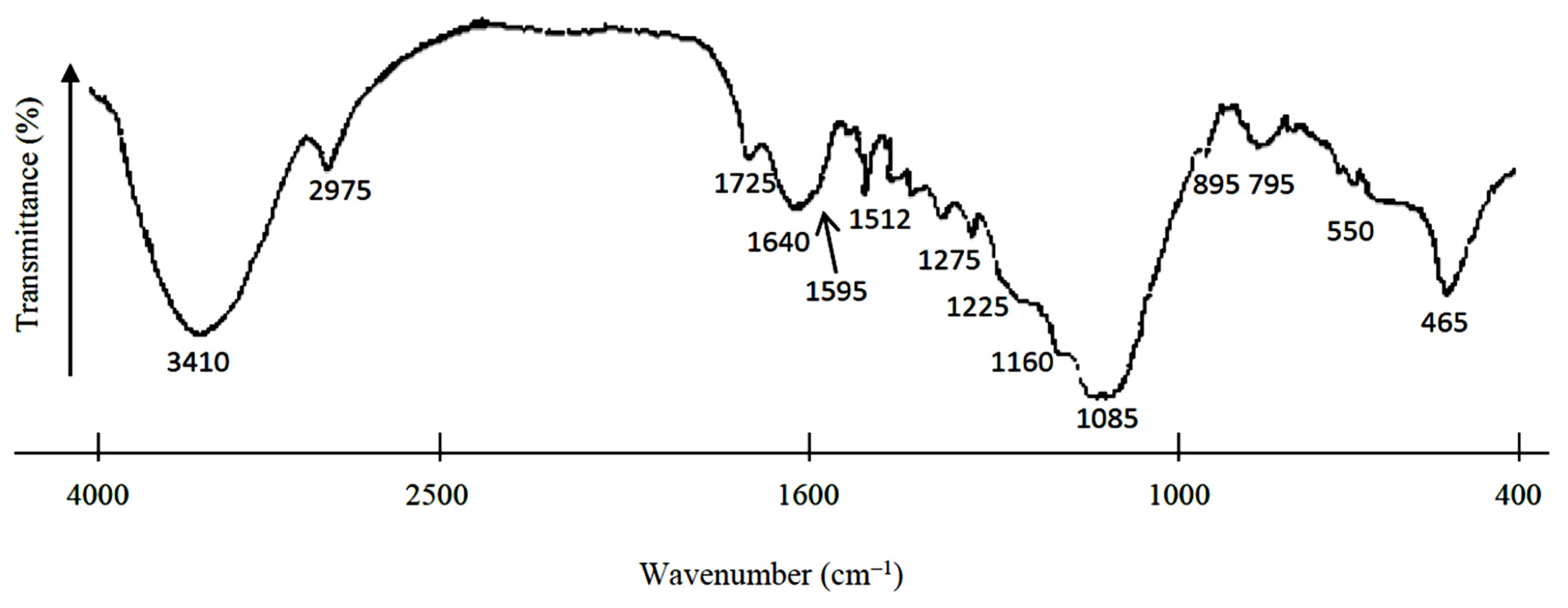
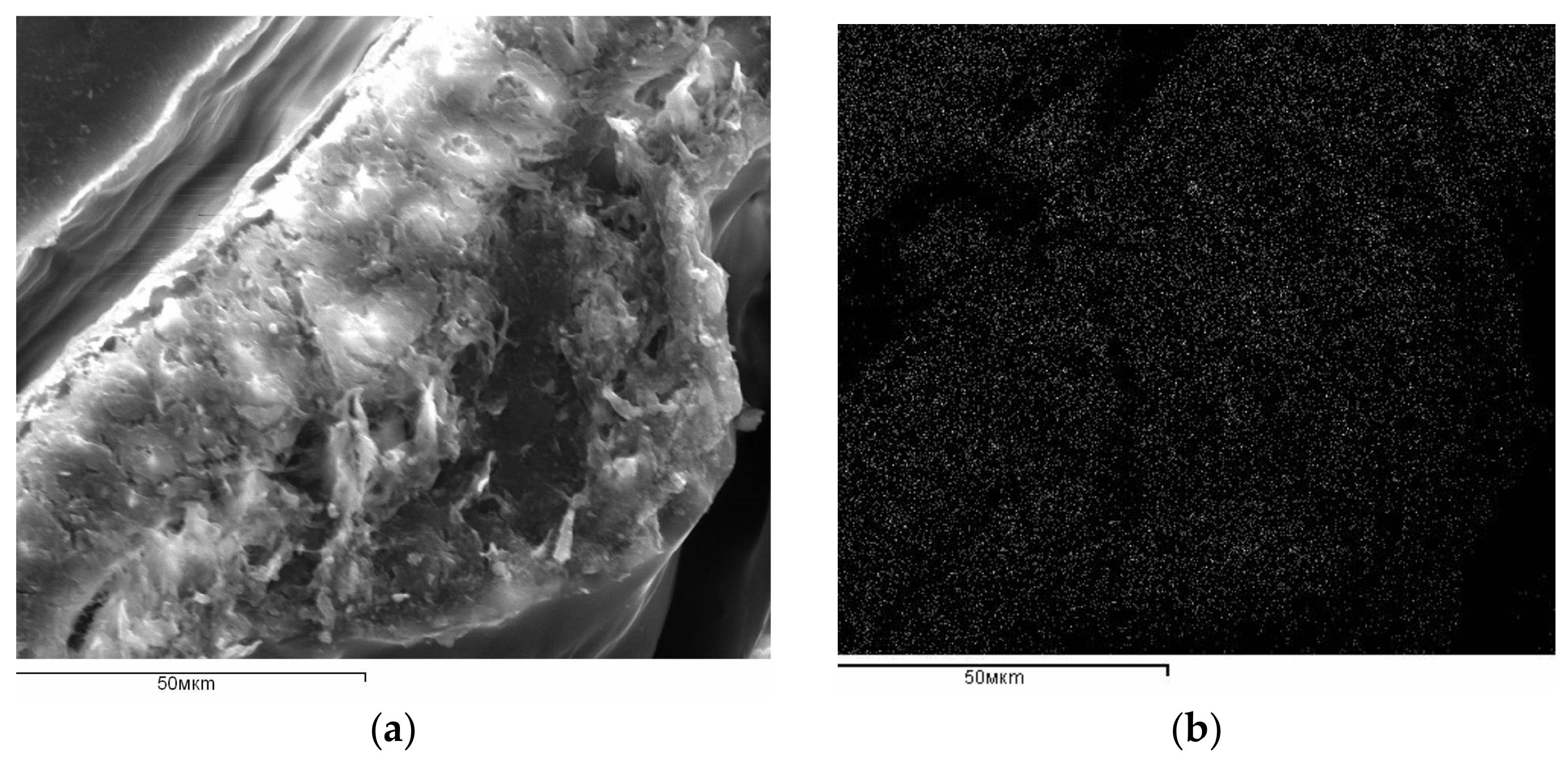

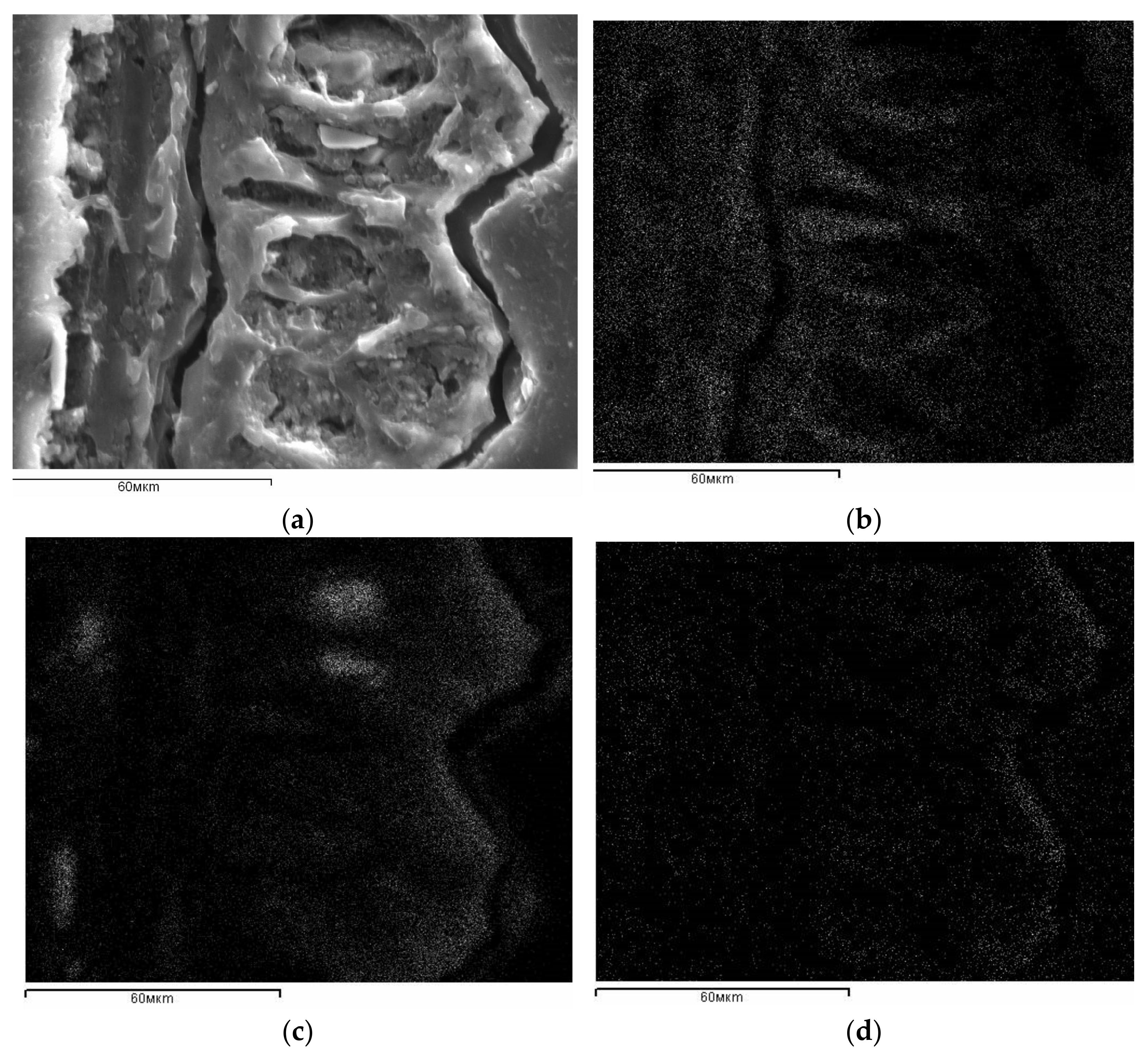
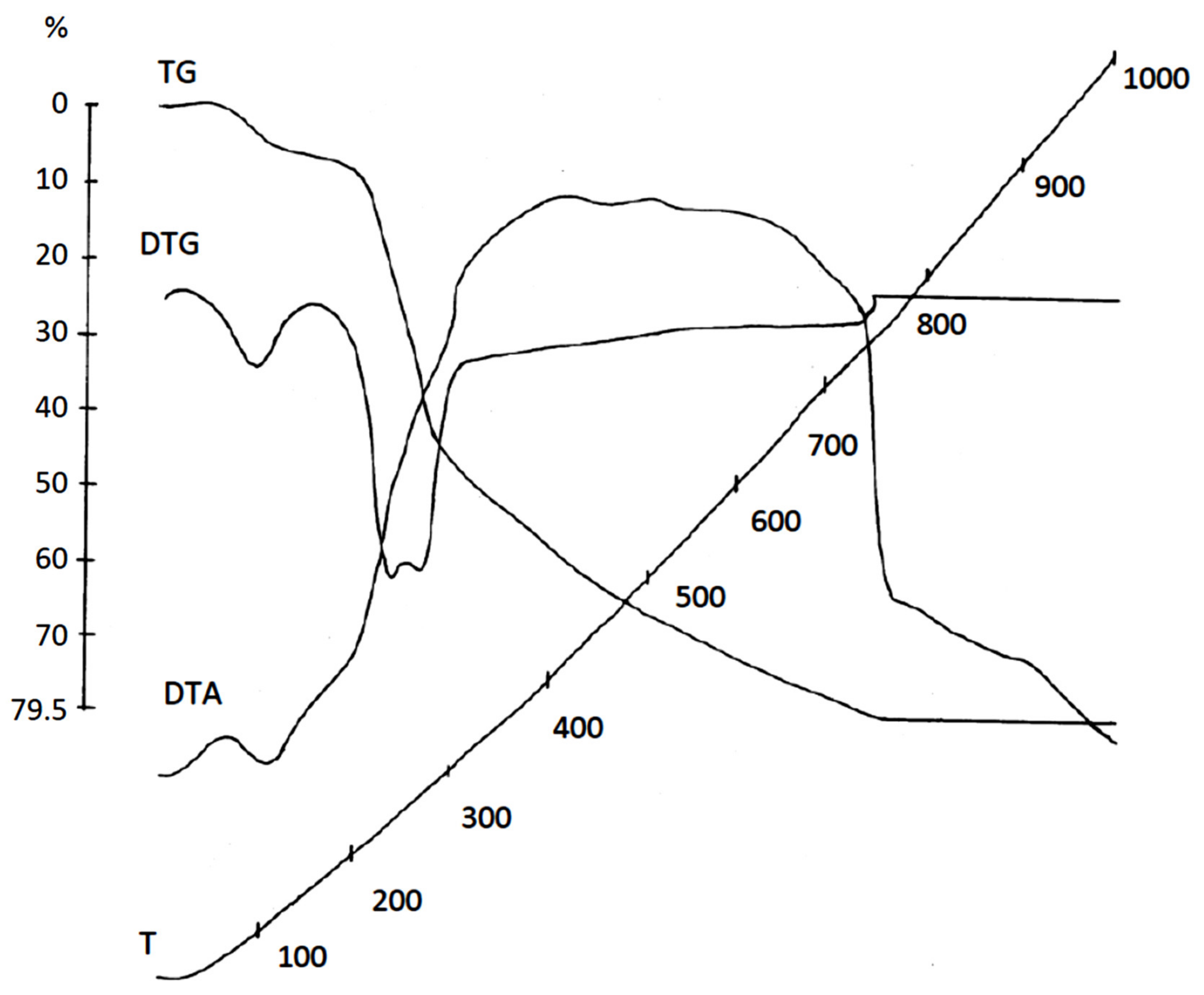
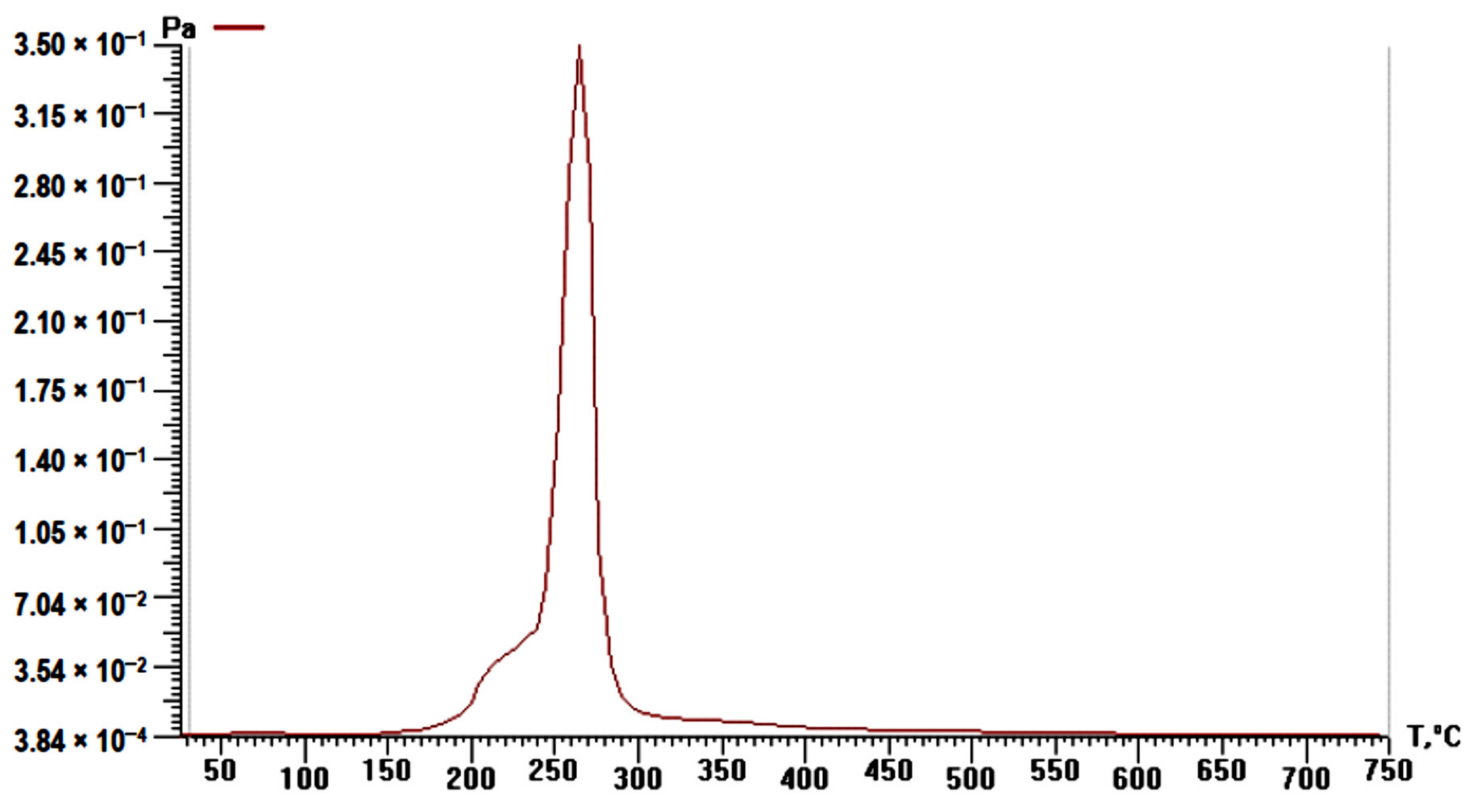
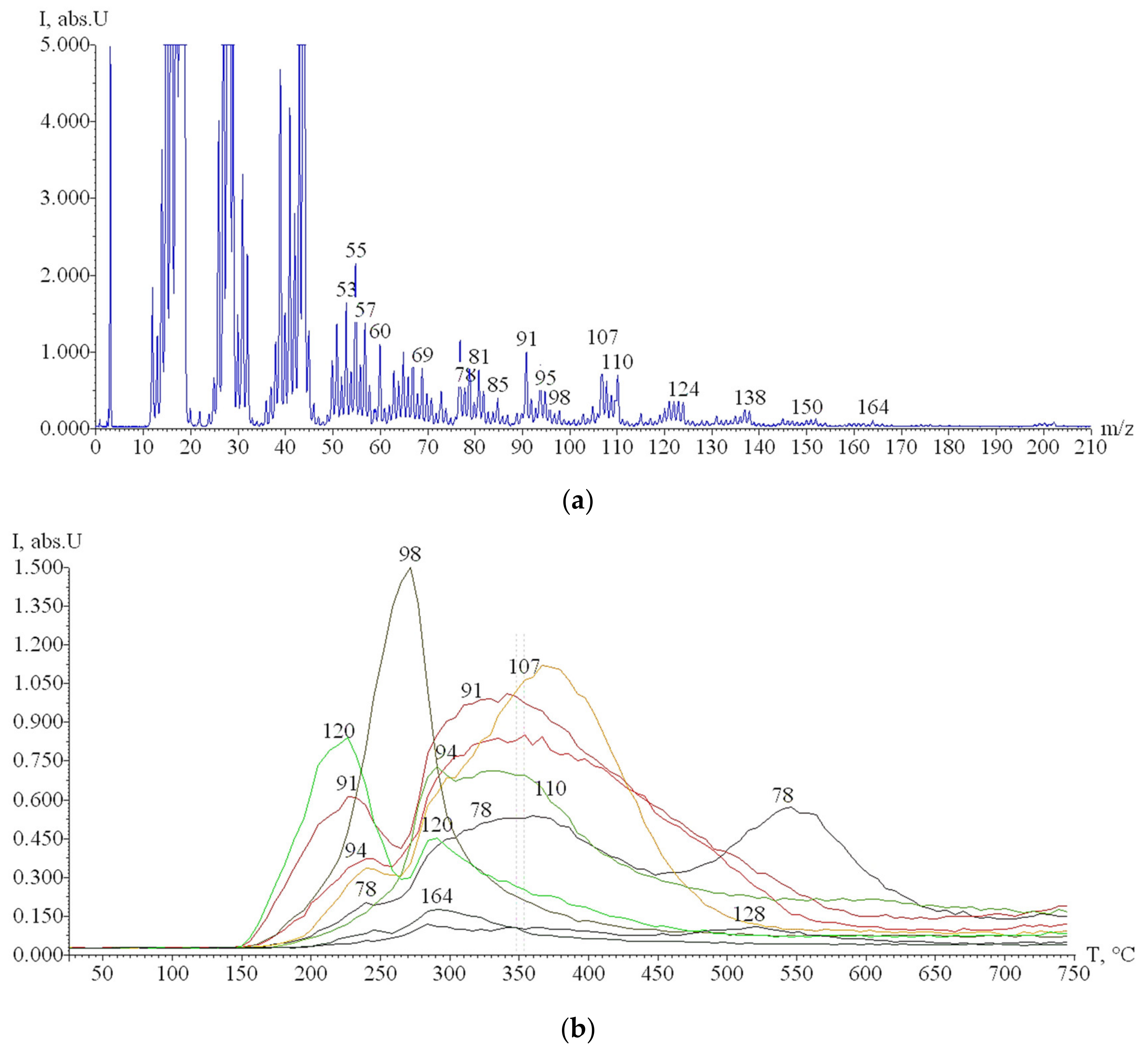
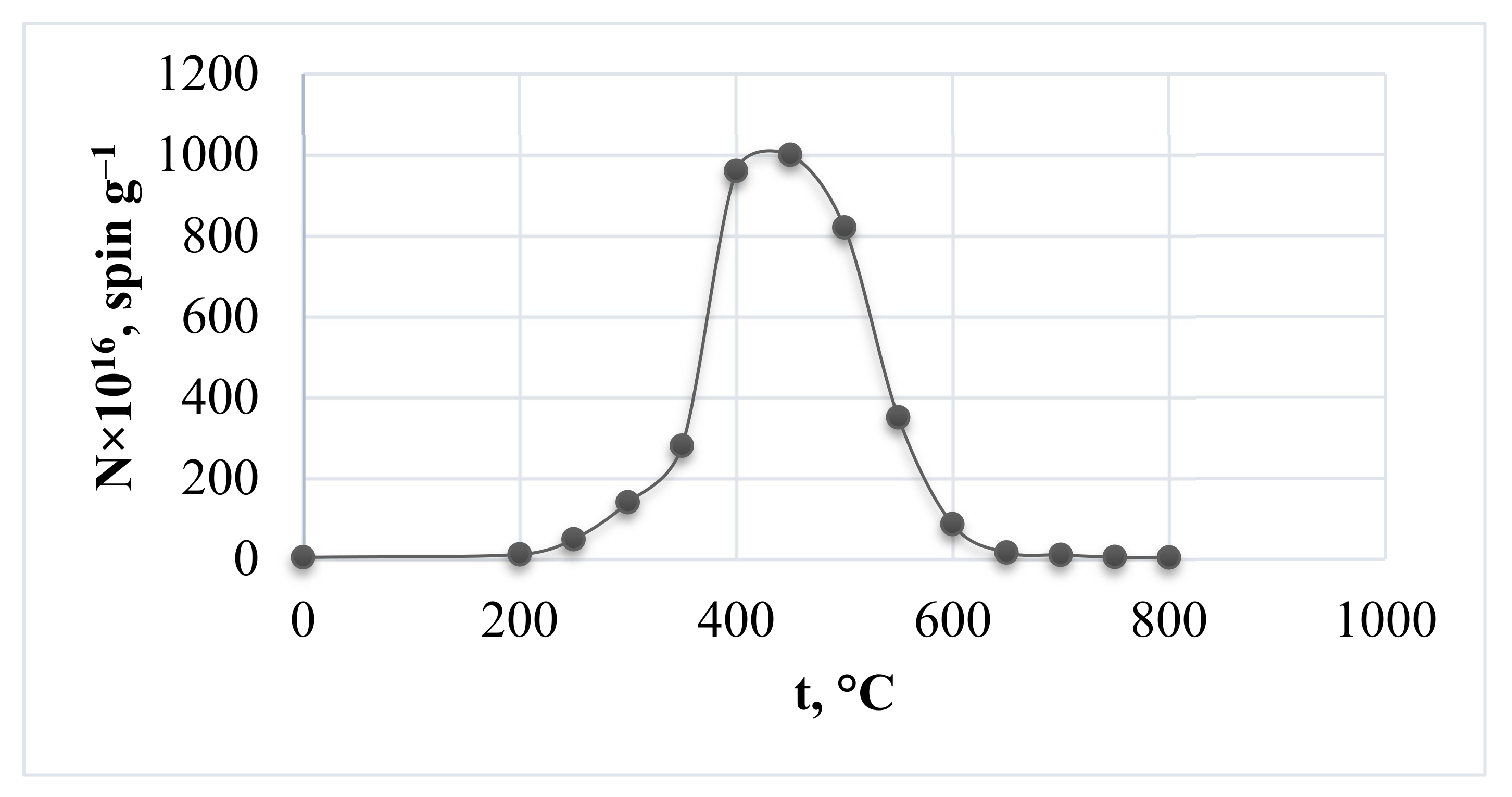
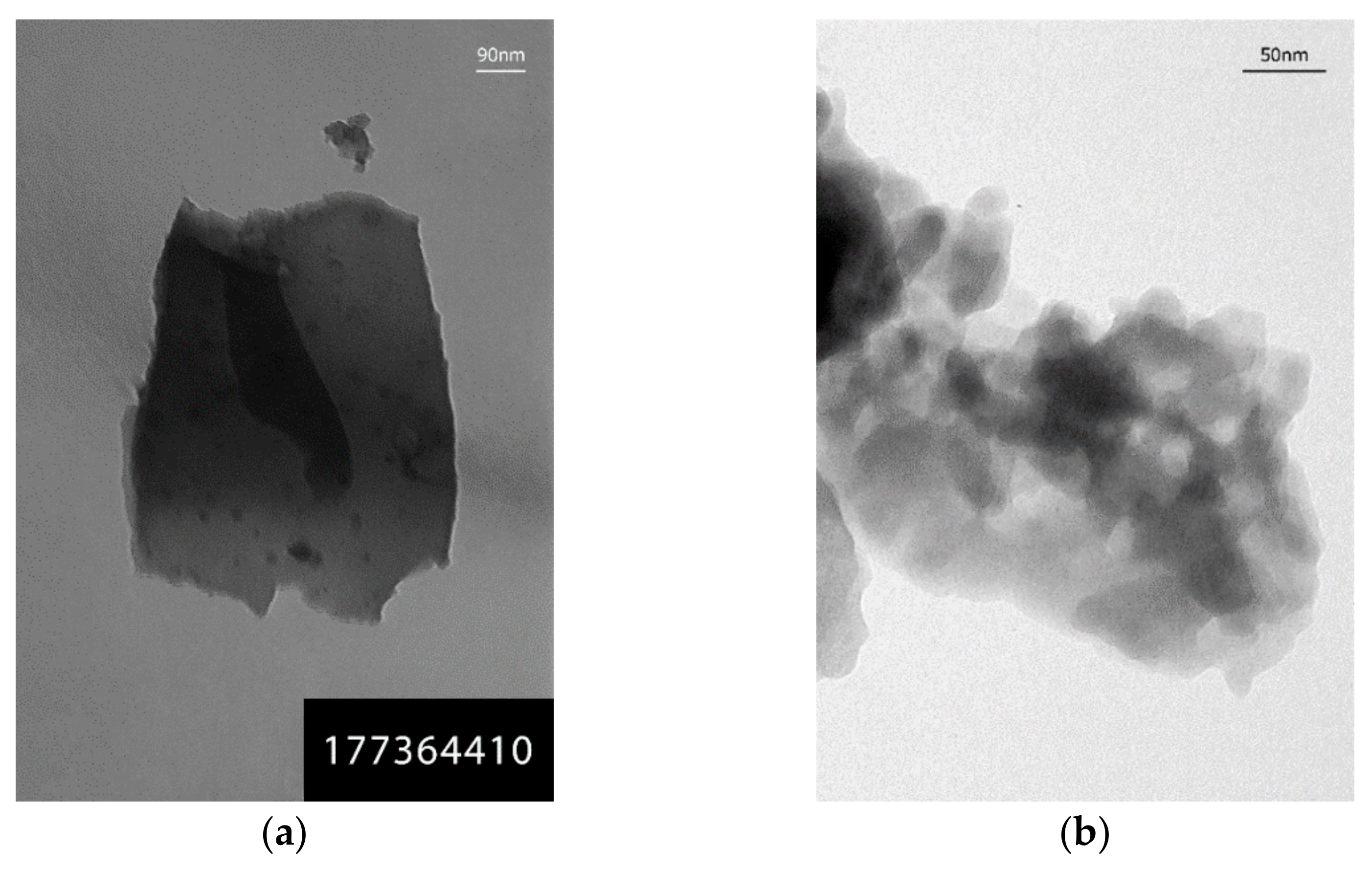
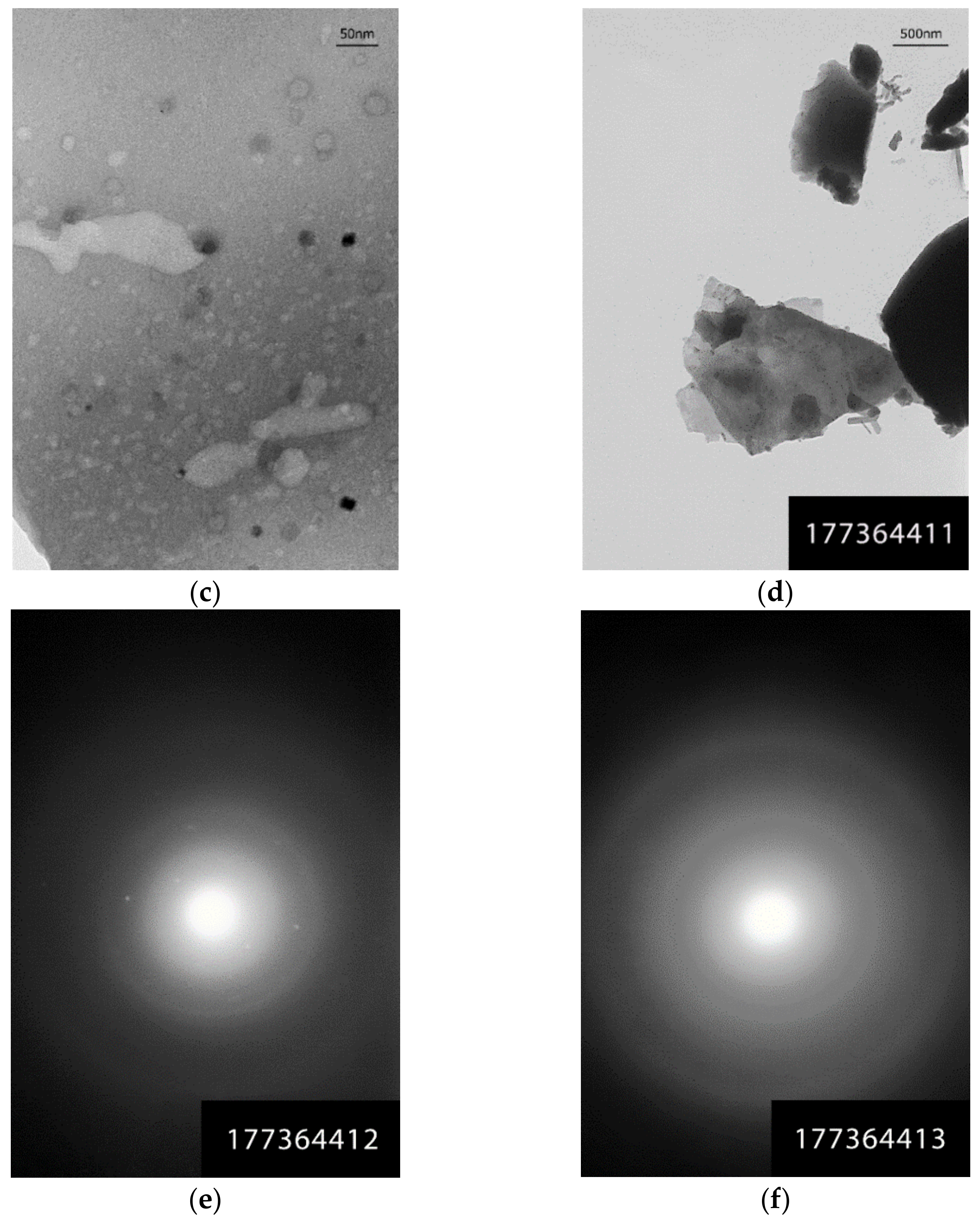

| Sample | PMCs Concentration, spin g−1 | EPR Line Width | g-Factor |
|---|---|---|---|
| RH | 4.4 × 1016 | 8.4 | 2.0041 |
| RH, 200 °C | 1.1 × 1017 | 7.4 | 2.0039 |
| RH, 250 °C | 4.9 × 1017 | 4.9 | 2.0030 |
| RH, 300 °C | 1.4 × 1018 | 4.8 | 2.0030 |
| RH, 350 °C | 2.8 × 1018 | 4.8 | 2.0029 |
| RH, 400 °C | 9.6 × 1018 | 5.7 | 2.0027 |
| RH, 450 °C | 1.0 × 1019 | 5.6 | 2.0027 |
| RH, 500 °C | 8.2 × 1018 | 4.6 | 2.0027 |
| RH, 550 °C | 3.5 × 1018 | 4.4 | 2.0027 |
| RH, 600 °C | 8.6 × 1017 | 3.8 | 2.0027 |
| RH, 650 °C | 1.6 × 1017 | 3.3 | 2.0027 |
| RH, 700 °C | 9.8 × 1016 | 2.9 | 2.0025 |
| RH, 750 °C | 4.6 × 1016 | 2.4 | 2.0025 |
| RH, 800 °C | 3.9 × 1016 | 2.5 | 2.0023 |
| RH, 650 °C, NaOH | 1.1 × 1019 | 4.8 | 2.0026 |
Publisher’s Note: MDPI stays neutral with regard to jurisdictional claims in published maps and institutional affiliations. |
© 2021 by the authors. Licensee MDPI, Basel, Switzerland. This article is an open access article distributed under the terms and conditions of the Creative Commons Attribution (CC BY) license (https://creativecommons.org/licenses/by/4.0/).
Share and Cite
Satbaev, B.; Yefremova, S.; Zharmenov, A.; Kablanbekov, A.; Yermishin, S.; Shalabaev, N.; Satbaev, A.; Khen, V. Rice Husk Research: From Environmental Pollutant to a Promising Source of Organo-Mineral Raw Materials. Materials 2021, 14, 4119. https://doi.org/10.3390/ma14154119
Satbaev B, Yefremova S, Zharmenov A, Kablanbekov A, Yermishin S, Shalabaev N, Satbaev A, Khen V. Rice Husk Research: From Environmental Pollutant to a Promising Source of Organo-Mineral Raw Materials. Materials. 2021; 14(15):4119. https://doi.org/10.3390/ma14154119
Chicago/Turabian StyleSatbaev, Baimakhan, Svetlana Yefremova, Abdurassul Zharmenov, Askhat Kablanbekov, Sergey Yermishin, Nurgali Shalabaev, Arsen Satbaev, and Vitaliy Khen. 2021. "Rice Husk Research: From Environmental Pollutant to a Promising Source of Organo-Mineral Raw Materials" Materials 14, no. 15: 4119. https://doi.org/10.3390/ma14154119






